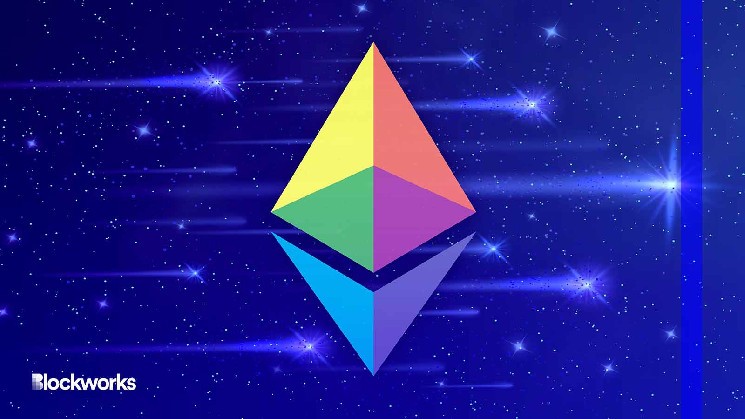What’ll Happen When 18M ETH Hits the Market? Maybe Less Than You Think

Ethereum’s long awaited Shapella upgrade is finally upon the crypto industry. Traders are now parsing how an unprecedented volume of unstaked ether will impact the price action of the ecosystem’s native token.
Shapella is set to tie together the protocol’s Shanghai upgrade and its Capella layer on Wednesday, making 18 million ether staked on the Ethereum blockchain available to trade.
Validators have been able to stake ether since September 2022, when Ethereum’s Merge executed, transitioning the blockchain from a proof-of-work consensus model to proof-of-stake transaction.
Ether (ETH) traded in a relatively narrow range over the past seven days as Shapella neared. Prices were roughly flat — up .46% — over the last 24 hours through 2 pm ET on Wednesday. During the same window, its dollar value fluctuated between a low of $1,863.37 and a high of $1927.35, according to Blockworks Research.
Just 170K ETH for sale?
About 18 million staked ether are set to be available for withdrawal once Shapella happens. Market analytics company Glassnode said on Tuesday that the firm expects traders to sell a scant 170,000 ETH “immediately after the Shanghai upgrade.”
Because there are Ethereum protocol-level limitations on how much staked ETH is unstaked daily, according to Glassnode, just 70,000 TH (around $133 million) “will actually become liquid” as a result.
Ether had a market cap of about $231 billion before the upgrade, according to Blockworks Research — and $4.3 billion of the asset had changed hands over the last 24 hours.
Just 1.3% of Ethereum validators, or 2,400, had already called it quits on the blockchain staking front by noon ET on Wednesday, according to Blockworks Research.
”Over the past few days, anyone who wanted to withdraw could have done so early to avoid being stuck in a long queue,” Blockworks Research wrote in a newsletter on Wednesday. “This could be a sign that there is very little desire to withdraw, or that most are waiting until post-upgrade.”
Institutional Ethereum interest reaching fever pitch
Christine Kim, vice president of research at Galaxy Digital, is an Ethereum specialist who contributes to the crypto investment firm’s research reports. Kim told Blockworks in an interview that Shanghai and other “core protocol developments” in the works on Ethereum have become “the focus of many discussions that I have with clients and other individuals,” adding that she “feels like I’ve been talking nonstop about it.”
Institutional traders are especially interested in the market impact stemming from the pending liquidity of ether rewards that stakers have accumulated since the launch of Ethereum’s beacon chain, she said.
Opinions vary on whether the unlocking of staked ether will be bullish or bearish for the industry. It depends, they say, on if you believe the crypto market is primed for a recovery in the near term. Macroeconomic factors like inflation may also be weighing on crypto assets like ether.
Kim said her view is that crypto broadly remains in a bear market, but added that Shapella is a potential bullish indicator. Even so, predicting exactly what will happen in terms of ether’s price and trading volumes as a result of the upgrade requires a “crystal ball” to an extent, according to Kim.
Predicting the selling activity of stakers is difficult because of their varied financial circumstances. Some large ETH validators, for instance, could be forced to sell in an effort to offset outstanding holes in their balance sheet, according to Kim. It is difficult to pin down precise metrics as a result.
Anecdotally, Kim said about three in 10 validators are expected to sell to “cover operational costs [accumulated] over the years.” She based that estimate in part on conversations with market participants.
In a Blockworks’ op-ed, Alluvial CEO Mara Schmiedt wrote that traders have not been paying enough attention to a related metric: Ethereum’s so-called churn limit, which could “create a significant entrance queue for staking — and could result in new stakers waiting days to weeks before they can start earning rewards.”
Ether stakers have shifted significantly
There’s also the matter of shifts in the validator control of Ethereum, according to Glassnode — especially when it comes to retail versus institutional stakers. US regulators have also played a role in cracking down on centralized staking.
The SEC’s move against crypto exchange Kraken is a prime example. Kraken settled with the SEC on two counts and without admitting or denying fault for $30 million in February.
And the relatively nascent “age” of Ethereum validators — which Glassnode pegged as being between six months to one year — is crucial in terms of parsing likely outcomes, the firm said.
Glassnode defined its metric for the age of Ethereum depositors as the “deployment date of a validator to [calculate] the average amount of time a depositor is participating in the staking economy.”

“We can see that the majority of depositors are between six months and one year old,” a Glassnode researcher wrote in the firm’s Tuesday note. “This indicates that there has been a growing confidence and trust in Ethereum’s staking economy over the past year, especially after the successful execution of the Merge and the near-term prospect of withdrawals being enabled.”






 Bitcoin
Bitcoin  Ethereum
Ethereum  Tether
Tether  USDC
USDC  TRON
TRON  Dogecoin
Dogecoin  Cardano
Cardano  Bitcoin Cash
Bitcoin Cash  Chainlink
Chainlink  Zcash
Zcash  Monero
Monero  LEO Token
LEO Token  Stellar
Stellar  Litecoin
Litecoin  Hedera
Hedera  Dai
Dai  Cronos
Cronos  Tether Gold
Tether Gold  OKB
OKB  Ethereum Classic
Ethereum Classic  KuCoin
KuCoin  Gate
Gate  Algorand
Algorand  Cosmos Hub
Cosmos Hub  VeChain
VeChain  Dash
Dash  Tezos
Tezos  TrueUSD
TrueUSD  Stacks
Stacks  Decred
Decred  IOTA
IOTA  Basic Attention
Basic Attention  Theta Network
Theta Network  NEO
NEO  Synthetix
Synthetix  Qtum
Qtum  Ravencoin
Ravencoin  DigiByte
DigiByte  0x Protocol
0x Protocol  Nano
Nano  Zilliqa
Zilliqa  Holo
Holo  Siacoin
Siacoin  Numeraire
Numeraire  Waves
Waves  Ontology
Ontology  Status
Status  BUSD
BUSD  Enjin Coin
Enjin Coin  Pax Dollar
Pax Dollar  Hive
Hive  Lisk
Lisk  Steem
Steem  Huobi
Huobi  OMG Network
OMG Network  NEM
NEM  Bitcoin Gold
Bitcoin Gold  Augur
Augur  HUSD
HUSD